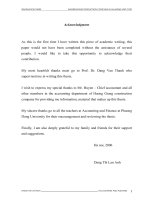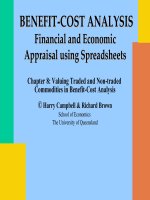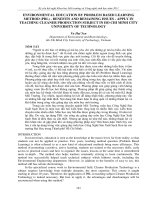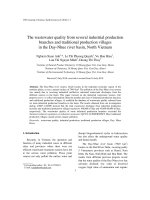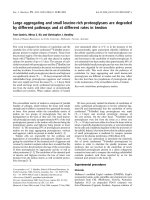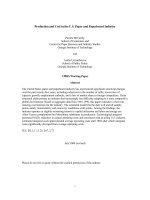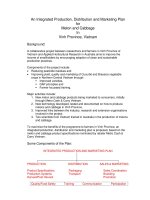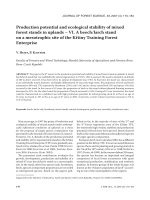“Aggregating production cost and evaluating unit cost in Huong Giang construction company”.
Bạn đang xem bản rút gọn của tài liệu. Xem và tải ngay bản đầy đủ của tài liệu tại đây (407.67 KB, 78 trang )
Graduation thesis
Aggregating production costs and evaluating unit cost
Acknowledgment
As this is the first time I have written this piece of academic writing, this
paper would not have been completed without the assistance of several
people. I would like to take this opportunity to acknowledge their
contribution.
My most heartfelt thanks must go to Prof. Dr. Dang Van Thanh who
supervised me in writing this thesis.
I wish to express my special thanks to Mr. Huyen – Chief accountant and all
other members in the accounting department of Huong Giang construction
company for providing me information, material that makes up this thesis.
My sincere thanks go to all the teachers at Accounting and Finance at Phuong
Dong University for their encouragement and reviewing the thesis.
Finally, I am also deeply grateful to my family and friends for their support
and suggestions.
Ha noi, 2006
Dang Thi Lan Anh
dang thi lan anh
accounting and auditing
1
Graduation thesis
Aggregating production costs and evaluating unit cost
Introduction
Capital construction is one of the national economy’s material production
branch, that takes an important position in building infrastructure process for
our country to come toward socialism. So each business must find out a
management method that suits its characters of production and makes the
highest economic effectiveness as well.
In market economy, almost the business trade for the profit goals. For
management of company, production costs and unit cost are important
economical indices because they reflect level quality of production operation.
They effect directly to the whole business operation and take the major to
enterprise’s existence and development. Therefore, the managers always try
to find out the solution to reduce production and unit cost to the minimum.
Only by aggregating production cost and evaluating unit cost adequate, exact
that help the managers analyze the operation results. Finally, they make
suitable decisions on management in order to enhance the production and
management mechanism organization.
Realizing the importance of operation production cost and unit cost in
general, specially in Huong Giang construction company where I did my
graduation training, I have come to decision to make the scope of this thesis:
“Aggregating production cost and evaluating unit cost in Huong Giang
construction company”.
The thesis includes three main chapters as follows:
dang thi lan anh
accounting and auditing
2
Graduation thesis
Aggregating production costs and evaluating unit cost
Chapter one: General theory of aggregating production cost and evaluating
unit cost in construction companies.
Chapter two: Huong Giang company ‘s accounting practices on aggregating
production cost and evaluating product of construction unit cost.
Chapter three: Solutions to perfect the quality of operation production cost
and unit cost accounting in Huong Giang company.
Chapter one
General theories of aggregating production costs
and evaluating unit cost in construction companies.
In this chapter, theory on accounting for aggregating production costs and
evaluating unit cost will be discussed. It includes major issues as follows:
• Concept of production costs and unit cost, classification and relationship
between production costs and unit cost.
• The tenor of aggregating production costs.
• Estimation of work in progress.
• Method of evaluating unit cost.
1. Production cost and classification of production costs in construction
company:
1.1. Definition:
Production costs represent the moneytary value of resourses used such as
labour materials, overhead incurred in production process that form the
product of construction unit cost in a given period of time.
1.2. Classification:
Production costs can be classified in many ways depending on goals and
requirements of management.
In calculating, there are some ways to classify production costs on the basis
of:
dang thi lan anh
accounting and auditing
3
Graduation thesis
Aggregating production costs and evaluating unit cost
1.2.1. Classification of production costs on the basis of economic content and
nature of costs.
According to this classification, production costs in construction company are
futher divided into these components:
• Raw materials cost
• Tools and supplies cost
• Fuel and oil cost
• Labour cost
• Depreciation of fixed assets
• Render – services
• Other expenses in cash
This classification shows the structure and percentage of each cost
component. It is the basis of making production costs statements following
elements and the plan of production costs for next period.
1.2.2. Classification of production costs on the basis of purpose and utility of
costs
According to this classification, the same goal and utility costs are gathered in
one component, it does not distinguish economic content of costs. Production
costs include these categories as follows:
•
Direct raw – materials cost
•
Direct labour cost
•
Equipment cost
•
Overhead costs
This classification is useful for the company to communicate the data to
evaluate unit cost, analyze the implementation of planned unit cost and
making production costs estimation for next period.
1.2.3. Classification of production costs on the basis of method of aggregating
production costs:
dang thi lan anh
accounting and auditing
4
Graduation thesis
Aggregating production costs and evaluating unit cost
Under this classification, production costs are divided into two categories:
•
Unique costs can be traced directly to specific product.
•
General costs are expenses that relating to many products. They are need
to separately aggregate to periodical allocate for costs center.
This classification helps the managers realize position of each costs in making
products to set up suitable method of aggregating production costs.
2. Unit cost of construction product and classification of unit cost:
2.1. Definition:
Unit cost includes all the production costs that a company has to pay to build
a finished construction.
Unit cost of construction product includes four components such as:
•
Direct raw – materials cost
•
Direct labour cost
•
Using equipment cost
•
Factory overhead costs
2.2. Classification:
At first, in order to classify unit cost, accountants have to compute estimation
of cost of construction product.
Estimation
of cost
=
Cost to finish the estimation
volume of construction
+
Normed
profit
Unit cost is a part of estimation cost that rounds up direct costs and indirect
costs following the finished volume of construction.
In accounting and management, unit cost of construction product can be
classified as follows:
2.2.1. Cost price of construction work:
dang thi lan anh
accounting and auditing
5
Graduation thesis
Aggregating production costs and evaluating unit cost
Cost price of construction work includes all the production costs to finish
volume of construction following the estimate.
Cost price of
construction work
=
Estimation
of cost
Normed
profit
-
Or :
Cost price of
construction
work
=
Volume of works following
the economic and
technique norms are
determined by Goverment
x
Unit price is announced
by Government for each
construction area and
other normed costs
Cost price of construction work is formed and existed in a given time. It’s
evaluated in medium conditions of construction production, management
organization, materials and labour expenses ... for each kind of work or for a
specific work. Cost price of construction work is sequently stability.
2.2.2. Planned unit cost:
Planned unit cost is evaluated on the basis of specific conditions features of
one construction company in a given planned period.
Therefore, planned unit cost is an index that business try to reach in order to
achieve the profit level thanks to decreasing unit cost in planned period. It
reflects the standard of company ‘s unit cost management.
Planned
unit cost
=
Cost
price
Profit base on
- decreasing unit cost
+(-)
Difference from
estimate
2.2.3. Assessed unit cost:
Assessed unit cost is the total expenses that cost to end a volume of
construction. It is calculated on the basis of structural feature, method of
building organization and management following costs norms that achieved at
the beginning of construction.
dang thi lan anh
accounting and auditing
6
Graduation thesis
Aggregating production costs and evaluating unit cost
Thus, assessed unit cost will changed following fluctuation method of
management and organization of construction or fluctuation structural feature.
So, it is recomputed to be suitable.
2.2.4. Actual unit cost:
Actual unit cost is the total costs incurred in construction process that is
aggregated by accountant.
The basic difference between actual unit cost with the above unit cost:
Structure of these above unit cost only include normed costs but actual unit
cost includes all costs incurred that means covering normed costs and extra
costs.
In short, in order to determine accurately the quality of construction
operation, it is need to compare those unit costs.
•
Comparing actual unit cost with planned unit cost shows the decreasing
level of planned unit cost.
•
Comparing actual unit cost with estimation of unit cost reflects the
accumulation index to expect the company ability in next period.
•
Comparing actual unit cost with assessed unit cost shows the finished
norms level of each specific volume of construction.
3. The relationship between production costs and unit cost.
Production costs and unit cost are two different terms of production process.
Production costs reflect the moneytary value that company cost in process
and unit cost reflects the results of production.
All the expenses create (on this period or transferred from previous period)
and precalculating costs that relate to volume of finished work will form the
unit cost of construction product.
Thus, production costs and unit cost have closed relationship. Production
costs are the base to evaluate unit cost of finished products. Saving or wasting
of production costs effect directly to increasing or decreasing of unit cost.
dang thi lan anh
accounting and auditing
7
Graduation thesis
Aggregating production costs and evaluating unit cost
Finally, management of unit cost must be linked to production costs
management.
The scheme of relationship between production costs and unit cost:
Costs in progress at the beginning
Total of unit cost of finished products
Total of unit cost of
finished products =
Costs create in process
Costs in process at the ending
Costs in progress
Costs create
+ in progress
at the beginning
-
Costs in process
at the ending
4. The objects and method of aggregating production costs:
4.1. The objects of aggregating production costs in accounting:
The objects of aggregating production costs are defined as scale and scope of
costs which accountant has to aggregate to satisfy the requirements of
checking and supervising the costs in building process.
In order to accurately determine costs objective, accountant has to base on
features of production costs and the use of cost in production.
•
The objects of aggregating production costs may be the whole
technological process or each specific stage fluctuation to production
mechanism organization, requirement and standard of economic
management and internal accounting requirements.
•
Following production process, product characters, the requirement of
evaluating unit cost, the costs objective may be each group of products or
each kind of products, or each component or details group, detail of
product.
In construction, product is specific so that the objects of aggregating
production costs may be the customer’s order, each construction, part of
building or group of buildings, as usual.
Aggregating production costs to adequate objects gives a good assistance to
production costs and manufacture administration, to internal and the whole
dang thi lan anh
accounting and auditing
8
Graduation thesis
Aggregating production costs and evaluating unit cost
accounting of company. Besides, it helps timely and accurately evaluating
unit cost.
4.2. Aggregating production costs method:
4.2.1. Aggregating and allocating direct raw materials cost:
Direct raw materials costs are costs of major materials, semi – finished
product, auxiliary materials, fuel oil ... used directly in manufacturing
products.
Direct raw materials costs are usually aggregated following direct method. It
is applied for direct raw materials costs that are only concerned in only one
cost objective.
If direct raw materials costs are concerned in many objects of aggregating
production costs, accountant has to use indirect method. That means
accountant has to determine the reasonable bases to allocate direct raw
materials costs by following formula:
Costs
allocate to
object i
General
criterion of
allocation
x of object i
Total costs to be allocated
=
General criterion of allocation of all objects
To accurately aggregate direct raw materials costs, accountant has to pay
attention to checking and evaluating the received materials but not using up
and value of received spent materials
to minus them out of direct raw
materials costs.
Actual
direct raw
materials =
costs
Raw materials
are used directly
for producing
process
-
The unused materials
distributed for
manufacturing are returned
and stored
-
Value of
received
spent
materials
According to Financial Regulation issued by Ministry of Finance, in order to
aggregate and allocate direct raw materials costs, account 621- “Direct raw
materials” is used.
dang thi lan anh
accounting and auditing
9
Graduation thesis
Aggregating production costs and evaluating unit cost
Chart 01: Direct raw materials costs accounting
A/C 152(611)
A/C 621
A/C 152(611)
Raw materials are used
The unused materials
directly for producing process
distributed for manufacturing
are returned and stored
A/C 111,112,331
A/C 154(631)
Raw materials are not stored
Transferring actual direct
and used immediately for
producing products
raw materials costs
No ending balance exists in A/C 621
4.2.2. Aggregating and allocating direct labour cost:
Direct labour costs are salaries payable to employees directly involved in
manufacturing. Salaries includes basic wages, allowances, not includes social
insurance (15%), trade union fees (2%), health insurance (2%).
Direct labour costs are usually computed directly to each relating costs
objective. If direct labour costs involve in many objects
that are not
calculated directly, they could be general aggregated and allocated to costs
objective by reasonable bases, at the ending of accounting period.
The common allocation bases are used such as assessed salary (or planned),
assessed hours wage or actual hours wage, volume of products ... following
the concretely condition.
According to Financial Regulation issued by Ministry of Finance, in order to
aggregate and allocate direct labour costs, A/C 622- “Direct labour costs” is
used. It can be opened sub – accounts depending on the features of operating
activities.
dang thi lan anh
accounting and auditing
10
Graduation thesis
Aggregating production costs and evaluating unit cost
Chart 02 : Direct labour costs accounting
A/C 334
A/C 622
A/C154(631)
Salaries and allowances
Transferring direct labour
payable to direct employees
costs to cost objects
A/C 335
Payable expenses for labour
costs on day’ leave
No ending balance in A/C 622
4.2.3. Aggregating and allocating factory overhead costs:
Factory overhead costs are general operating expenses supporting the process
of producing created at construction brigades such as expenses for factory
employees, the costs of tools, supplies utilised for factory, depreciation of
fixed assets, expenses for services rendered and expenses paid in cash. It also
includes trade union fees, social insurance, health insurance deducted from
wages of direct labour, construction machinery operator and management
staff.
Factory overhead costs are aggregated at each place. At the end of month,
aggregated overhead costs are transferred to evaluate unit cost.
Factory overhead costs of which brigades will be transferred to that brigade to
evaluate unit cost of its product. If one brigade produces many products in the
period, factory overhead costs will be allocated to each costs objective.
Factory overhead costs can be allocated on the basis of:
• Actual hours wage of worker.
• Direct materials costs.
dang thi lan anh
accounting and auditing
11
Graduation thesis
Aggregating production costs and evaluating unit cost
• Direct materials and labour costs.
• Assessment of factory overhead costs.
It can be allocated according to the formula:
Volume of factory
overhead costs are
allocated to each
cost objective
General criterion of allocation of all objects
=
x
General criterion of allocation of each object
Total factory
overhead
costs must
be allocated
According to Financial Regulation issued by Ministry of Finance, in order to
aggregate and allocate factory overhead costs, A/C 627 – “Factory overhead
costs” is used. Accountants may open some sub- account to record specific
expenses for their own operations.
In addition, upon the Directive 89/2002/TT-BTC: Guidung accountants to
practice four Vietnamese accounting standards issued following Decision
149/2001/QD-BTC dated December 31/2001 of Minister of Finance, Ministry
of finance supplements account 242 – “Long term prepaid cost”. This account
used to record expenses which relate to several fiscal periods and they
therefore can not be charged wholly to the current period but should be
allocated to the periods in which they relate.
Chart 03 : Factory overhead costs accounting
A/C 334,338
A/C 627
Salaries , allowances payable
to factory employees and
social insurance , health
insurance , trade union fees for
worker , machinery operator
dang thi lan anh and factory employees
A/C 154(631)
Allocating and transferring
fixed factory overhead costs
Decreased depreciation
of intangible fabricating cost
to each unit ‘s fixed assets
is differentnormal capacity
Fixed factory overhead costs
following from a certain
are not allocated in case that
amount that presets aside auditing
accounting and
12
because of production
actual levelfluctuation of is A/C 632
less time or method
than normal capacity 241(3)
A/C
Graduation thesis
Aggregating production costs and evaluating unit cost
A/C 152
Materials costs
A/C 153
Tools are used with low value
A/C 142,242
Tools with
The first
high value
allocation
A/C 111,141,331
Expenses rendered and
others in cash
A/C 241(3)
Depreciation of fixed assets
Increased depreciation level
because of fluctuation of
depreciation method or time
A/C 241
Repairing and upgrading fixed
assets with short value that
not satisfied the condition of
recording increased cost
No ending balance in A/C 627
4.2.4. Aggregating and allocating machinery cost:
dang thi lan anh
accounting and auditing
13
Graduation thesis
Aggregating production costs and evaluating unit cost
Equipment costs includes two types:
•
Temporary costs are one time incurred costs that relating to
assembling, removaling, carriage machines and others for temporary
constructions supporting for using equipment.
This kind of costs are allocated following the using time of temporary
constructions or construction period at building site (which is shorter will be
choosed to be allocation base). Calculating the monthly volume of allocation
as follows:
Volume of
temporary
cost
monthly
allocation
Actual costs to
build temporary
constructions
+
Estimated disassembling
temporary construction
costs
-
Estimated
recoverable value of
spent materials
=
Using time of temporary constructions or
construction period at work camp
Temporary costs are also calculated by preseting aside into equipment costs.
When ended using temporary constructions, the differences between actual
incurred cost with preset aside costs are recognized as regulations.
• Regular costs include daily incurred for using machines process such as:
fuel , oil costs, other auxiliary materials costs, salaries of machinery
operators, depreciation of fixed assets, rendered machines costs. These
expenses are computed one time to equipment costs in period.
4.2.4.1. Company has organized separate equipment brigades with accounting
classifications. These brigades have their own accounting work.
a. If company practice by method of supply equipment services among
internal sections, the accounting chart as follows: (Chart 04)
A/C 111,152 ...
A/C621,622,627
A/C154
A/C 623
Aggregating
Transferring costs to
Allocating
actual costs
evaluate unit cost
equipment costs
to objects
dang thi lan anh
accounting and auditing
14
Graduation thesis
Aggregating production costs and evaluating unit cost
b. If company practice by method of purchase equipment services among
internal sections:
A/C 111,152 ,...
A/C 621,622,627
A/C 154
A/C 632
Actual price of purchased
Machines shift
A/C 512
A/C 623
Purchased price
Computing to equipment cost
A/C 333(1)
A/C 133(1)
Taxes payable to state budget
Taxes deducted
4.2.4.2. Company has not organized separate equipment brigade or organzied
but not graded them:
A/C 334
A/C 623
Salaries pay to workers
A/C 214
Depreciation of construction equipment
A/C 152,153
Materials, tools are used for construction machines
A/C 111,112,331...
dang thi lan anh
accounting and auditing
Other expenses for construction machines
A/C 133(1)
15
Graduation thesis
Aggregating production costs and evaluating unit cost
* Equipment costs are allocated to reasonable construction objects basing on
volume of machines shift or actual served work.
•
In case that using equipment cost are particularly accounted to each kind
of machines be allocated to each object :
Equipment
costs are
allocated
to each
object
•
Total equipment costs must be allocated
x
=
Total actual machines shift or
implementation volume of building
Volume of actual
machines shift or
volume of work
are served for
each object by
machine
If company does not account specific to each kind of machine,
accountants have to evaluate standard machines shift through reduction
factor:
H
Planned price of one machines shift
=
Planned price of lowest one machines shift
Standard
machines shift
of each
operated kind
Equipment
costs are
allocated
to each
object
=
Volume of actual
operated machines shift
of each machine
x
H
Total equipment costs must be allocated
=
dang thi lan anh
x
Total reducted standard machines shift of all machines
Reducted
machines
shift serving
for each
object
accounting and auditing
16
Graduation thesis
Aggregating production costs and evaluating unit cost
4.2.5. Aggregating production costs accounting:
Production costs are needed to transfer in order to aggregate the whole
operation expenses and detailed in each object after particularly accounting
for each component such as: direct raw materials costs, direct labour costs,
using equipment costs, factory overhead costs.
Accountants depend on aggregating production costs by using perpetual
inventory method or periodical inventory method to use accounts.
•
If company applies perpetual inventory method, accountants use account
154 – “Work in progress” to aggregate production costs.
Chart 05.1 : Aggregating production costs
( Perpetual inventory method )
A/C 621
A/C 154
A/C 152
Transferring direct raw
Unused raw materials are
materials costs
returned and stored
A/C 622
A/C 138
Transferring direct labour costs
Reiceivable reimburse
A/C 336(2)
A/C 627
Transferring factory overhead costs
Actual price of finished
construction products hand
over to main contractor
A/C 155)
A/C 623
Transferring equipment costs
dang thi lan anh
Actual price of finished
construction products stored
Actual price of finished
accounting and
construction products auditing 17
A/C 632
hand over to customer
Graduation thesis
Aggregating production costs and evaluating unit cost
• If company applies periodical inventory method, accountants use account
631 to aggregate production costs, account 154 is only used to reflect the
value of work in progress at the end of the period.
Chart 05.2: Aggregating production costs
(Periodical inventory method )
A/C 154
A/C 631
A/C 154
Transferring the value of work
in progress at the
Transferring the value of
work in progress at the
beginning of the period
ending of the period
A/C 621,622,623,627
Transferring direct raw
materials costs , direct labour
costs , factory overhead costs ,
equipment costs
dang thi lan anh
A/C 152,138
Scraps and other reiceivables
A/C 632
Total value of finished products
accounting and auditing
18
Graduation thesis
Aggregating production costs and evaluating unit cost
5. Estimation of work in progress:
Work in progress of construction company include construction are in
building, volume of work are not accepted to pay by contractor.
Accountants have to evaluate actual unit cost of finished product in
accounting period following formula:
Actual unit
cost of
finished
product
=
Value of work
in progress at
the beginning
of the period
+
Production
costs arising
in accounting
period
-
Value of
work in
progress at
the ending
In order to evaluate value of work in progress at the ending, we must estimate
exactly the volume of work in progress, determine the finished level and use
the reasonable to evaluate.
There are many ways to evaluate work in progress on the basis of handing
over method between contractor and construction brigades.
5.1. In case that handing over when construction is whole finished:
Under this case, the sum of production costs from the beginning of building to
the time of estimate are actual costs of work in progress.
It always applies for correction and finishing work, low value constructions
building, short construction period following the contract that are accepted to
pay when whole finishing by contractor.
5.2. In case that handing over as each finished stage:
Work in progress are unfinished construction stages. Evaluating costs of work
in progress at the ending of the accounting period by allocating actual costs. It
is on the basis of cost price and degree of finishing.
Cost price of work in progress
of eacs stage at the ending
=
Allocation
Costs of work in progress
coefficient
at the beginning
actual
costs for
=
Actual costs of
Cost price of
unfinished
work in
work in
stage
dang thi lan anh
Cost of
progressprice of volume of finished
progress at
product
each stage handing over inending
the period
=
x
Cost price of
each stage
+
Percentage finished of
each stage
Costs in the period
+
Totalaccounting of allauditing
cost price and stage
unfinished products
Allocation
x coefficient
19
Graduation thesis
Aggregating production costs and evaluating unit cost
5.3. In case that handing over as periodical finished product of each work
or each structural part:
Calculating actual costs of volume of unfinished products at the ending by
formula as follows:
Cost price of each
unfinished product
Actual
costs of
volume of
unfinished
products
Volume of unfinished
products
Costs of work in progress
at the beginning
+
x
Estimated
unit cost
+
Percentage
finished
Cost price of
unfinished
product at
the ending
Costs in the period
=
Cost price of volume of
finished product handing
over in the period
x
x
=
Total cost price of
volume of unfinished
products
6. The objects and the method of evaluating unit cost.
6.1. The objects of evaluating unit cost:
The objects of evaluating unit cost are products, works which are
manufactured by enterprise.
In construction activity, because each product has its own estimation and
design, so the objects of evaluating construction unit cost are construction, or
volume of finished product.
dang thi lan anh
accounting and auditing
20
Graduation thesis
Aggregating production costs and evaluating unit cost
* The objects of aggregating production costs are usually equal to the objects
of evaluating unit cost, in capital construction.
The costs objective are the constructions followed customer’s order, and the
objects of evaluating unit cost are finished products.
6.2. Evaluating unit cost period in capital construction:
Due to products of construction are manufactured following each order with
long cycle, construction is only finished when ending a production cycle, so
evaluating unit cost period usually choosed is the time of handing over
finished constructions to use.
Therefore, evaluating unit cost period may be not suitable with accounting
period , it is suitable with production cycle.
6.3. The method of evaluating unit cost:
The method of evaluating unit cost is method of using aggregated production
costs data and other relating data to calculate total unit cost and unit cost of
finished product on the basis of determined objects.
In construction company, methods are usually applied such as follows:
6.3.1. Evaluating unit cost by simple method :
This method is applied in case that the objects of evaluating unit cost and
costs objective are the same, the evaluating unit cost period is suitable with
accounting period.
According to this method, unit cost is evaluated by formula:
Unit
cost
=
Costs of work in
progress at the
beginning
+
Production costs
incurred in the
period
-
Costs of work in
progress at the
ending
6.3.2. Evaluating unit cost by grand total costs:
dang thi lan anh
accounting and auditing
21
Graduation thesis
Aggregating production costs and evaluating unit cost
This method is applied in case that company builds high value constructions,
production costs are aggregated following each brigade and unit cost is
evaluated to each finished product.
Unit cost is evaluated by formula:
Unit
cost
Costs of work
in progress at
the beginning
=
The sum of production
costs of brigades that
construct a building
+
-
Costs of work
in progress at
the ending
6.3.3. Estimating unit cost in comformity with customer’s order:
It is the popular method.
According to this method, costs objective and the objects of evaluating unit
cost are customer’s orders. However, in order to satisfy the requirements of
work and because they have their different own estimation so actual unit cost
of each construction is calculated by formula:
Actual unit
cost
=
Cost price of
construction
Total production costs aggregated in the period
x
Total cost price of constructions
6.3.4. Evaluating unit cost by assessment method:
This method is applied when company had computed assessed unit cost of
each construction following each component of unit cost.
Accountants aggregate actual production costs by each component to compare
with assessed costs and to evaluate unit cost by formula:
Actual total
unit cost
=
dang thi lan anh
Assessed total
unit cost
+(-)
Differences from
assessment
+(-)
Justified
differences
accounting and auditing
22
Graduation thesis
Aggregating production costs and evaluating unit cost
6.3.5. Evaluating unit cost by coefficient and percentage method:
This method is applied when costs objective are group of same kind products
or the whole production process. Object of evaluating unit cost is each
finished product made by this process.
Unit cost of
standard product
=
Total unit cost of all kind of products
Total of reducted standard product
=
Unit cost of each
kind of product
Total of reducted
standard product
dang thi lan anh
=
Unit cost of
standard product
The sum of
x
Volume of
product i
Reduction factor
of each kind
x
Reduction factor
of product i
accounting and auditing
23
Graduation thesis
Aggregating production costs and evaluating unit cost
Chapter II
Accounting practices on aggregating production costs
And evaluating unit cost in Huong Giang construction company.
In this section, we are going to look at the following issues related to the
Huong Giang company:
• Foundation history.
• Production and management organization.
• Accounting work and accounting mechanism organization.
1. Production and business management organization:
1.1. Foundation history of Huong Giang construction company:
Huong Giang construction company – Ministry of National Defense was
established under the decision 501/QD-QP dated 18/04/1996 by the Minister
of National Defense, on the basis of incorporation of two enterprises:
Construction enterprise 17/5 and Coal exploit enterprises 30/4.The
headquarter of company is located at A7, Tan Mai – Hai Ba Trung – Ha Noi.
Huong Giang company is a State owned enterprise. It has a number of capital
as follows: 7.315.116.041 VND .
It devides into:
- Fixed capital
: 5.323.330.443 VND .
- Current capital : 1.991.785.598 VND .
And includes:
dang thi lan anh
accounting and auditing
24
Graduation thesis
Aggregating production costs and evaluating unit cost
- Amounts granted by the Ministry of National Defense : 2.069.076.220
VND.
- Amounts granted by the National budget
: 1.200.000.000
VND .
- Amounts undistributed earnings
:
950.423.721 VND
.
Over the past years, company has tried its best to complete the duties.
Company has achieved high production results, increase business surplus and
step by step expand its capital. At present, the company’s market is all over
the nationwide.
The company’s growth and development in recent years are presented in
following table:
Some indexes reflect practices for producing and business of company.
Index
1. Gross product
2. Revenue
3. Distribution in State
Unit
VND
VND
VND
Year 2000
35.678.000.000
26.818.432.331
1.729.453.340
Year 2001
37.360.000.000
33.856.604.557
2.308.766.381
budget
4. Employees
5. Salary per person
Person
VND
524
790.000
554
916.000
1.2. Production and management organization:
1.2.1. Feature of technology production process:
The major products of Huong Giang construction company are constructions,
construction items such as: civil works, industrial buildings, water
communication works, bridgeworks... The construction scale is not the same,
dang thi lan anh
accounting and auditing
25
